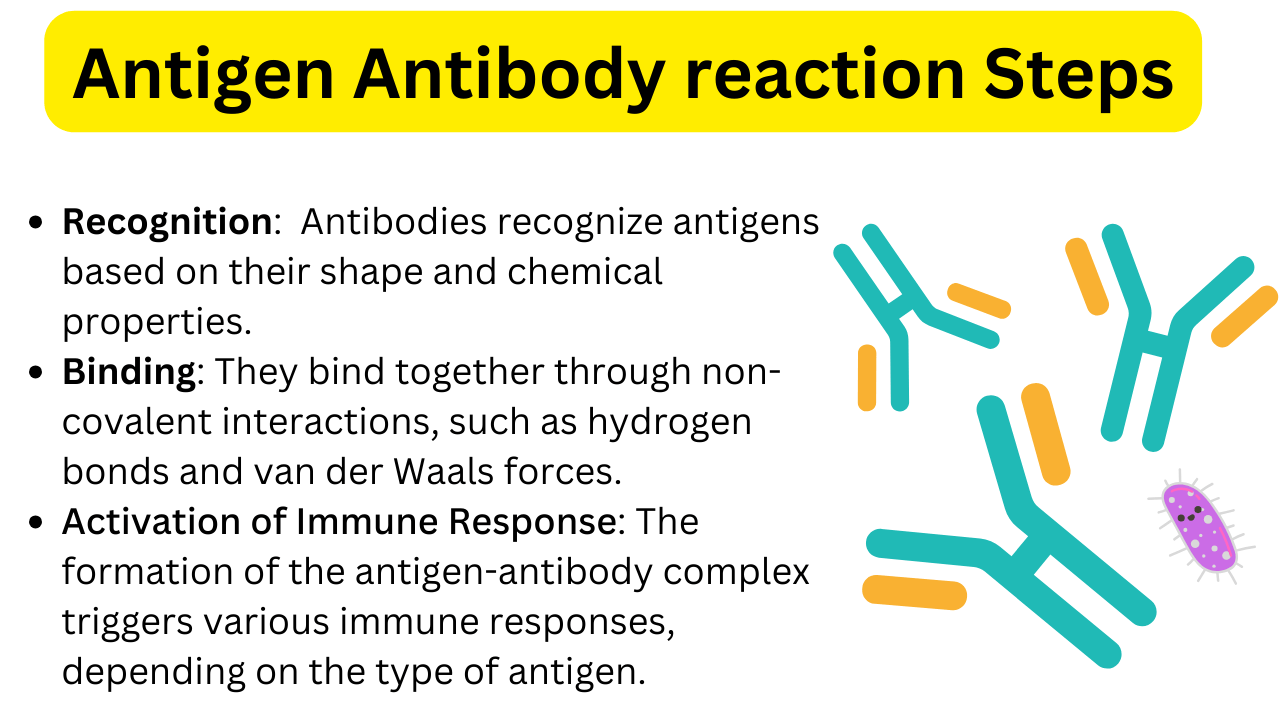The antigen antibody reaction also known as antigen-antibody binding. It is a fundamental concept in immunology that plays a critical role in our body’s defense against pathogens and foreign substances.
This interaction involves antibodies ( which are proteins produced by the immune system) binding to specific antigens (which are molecules found on the surface of pathogens or foreign substances).
Here you will learn about the main aspects of the antigen-antibody reaction, its significance in immunity, and its applications in various fields.
What is Antigens?
- Antigens are substances that can stimulate an immune response in the body. They are typically foreign molecules, such as proteins, glycoproteins, glycolipids, or even parts of microorganisms like bacteria, viruses, or fungi.
- Antigens are recognized by the immune system as non-self and can trigger an immune response, leading to the production of antibodies.
What is Antibodies (Immunoglobulins)
- Antibodies are Y-shaped proteins produced by specialized immune cells called B lymphocytes (B cells).
- Each antibody molecule has a specific binding site, known as the antigen-binding site, which allows it to recognize and bind to a particular antigen with high specificity.
What is Antigen Antibody Reaction?
The antigen-antibody reaction occurs when antibodies encounter their corresponding antigens. This interaction is highly specific, similar to a lock-and-key mechanism. Each antibody is tailored to recognize a particular antigen. This reaction involves the following steps:
- Recognition: Antibodies recognize antigens based on their shape and chemical properties. The binding site on the antibody matches the antigen’s structure.
- Binding: Once the antibody and antigen recognize each other, they bind together through non-covalent interactions, such as hydrogen bonds and van der Waals forces. This binding is reversible and forms an antigen-antibody complex.
- Activation of Immune Response: The formation of the antigen-antibody complex triggers various immune responses, depending on the type of antigen. This can include neutralization of the antigen, complement activation, opsonization (marking antigens for phagocytosis), or agglutination (clumping of pathogens for easier removal).
Significance of antigen-antibody reaction in Immunity
The antigen-antibody reaction is central to the immune response and has several crucial roles:
- Pathogen Neutralization: Antibodies can neutralize pathogens by binding to their surface antigens, preventing them from infecting host cells.
- Immune Memory: After an initial encounter with an antigen, the immune system produces memory B cells that “remember” the antigen. If the same antigen reappears, the immune system can mount a faster and more effective response.
- Vaccine Effectiveness: Vaccines work by introducing harmless forms of antigens into the body. This stimulates the production of antibodies, providing immunity without causing the disease.
- Diagnostic Tools: Antigen-antibody reactions are used in diagnostic tests like ELISA (enzyme-linked immunosorbent assay) to detect specific antibodies or antigens in blood samples, aiding in the diagnosis of various diseases.
- Blood Typing: Blood transfusions rely on the antigen-antibody reaction to determine blood compatibility. The ABO and RhD blood group systems are examples of this principle.
Applications of antigen-antibody reaction Immunology
The antigen-antibody reaction has applications beyond immunology:
- Biotechnology: It is used in techniques like Western blotting, immunoprecipitation, and flow cytometry for protein analysis and purification.
- Pregnancy Tests: Pregnancy tests detect the presence of human chorionic gonadotropin (hCG) in urine, using an antigen-antibody reaction.

2 thoughts on “Antigen Antibody reaction steps , applications”